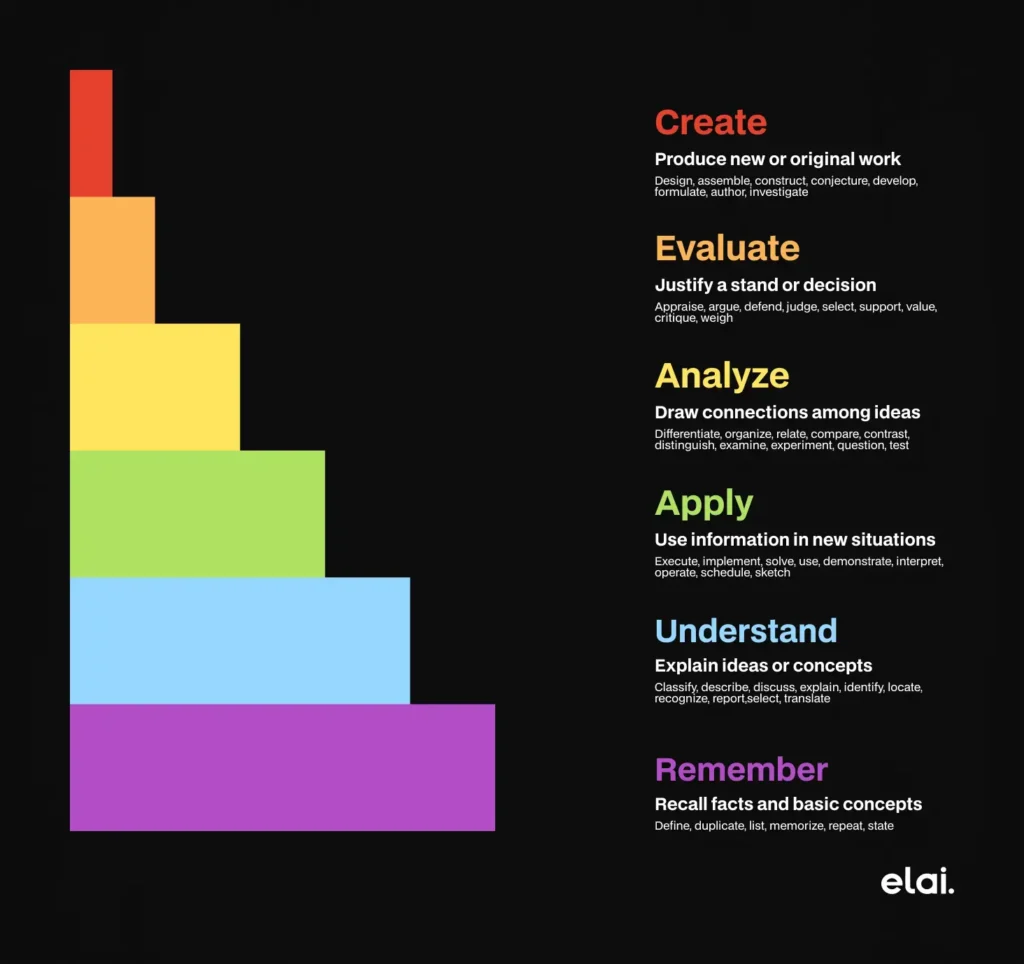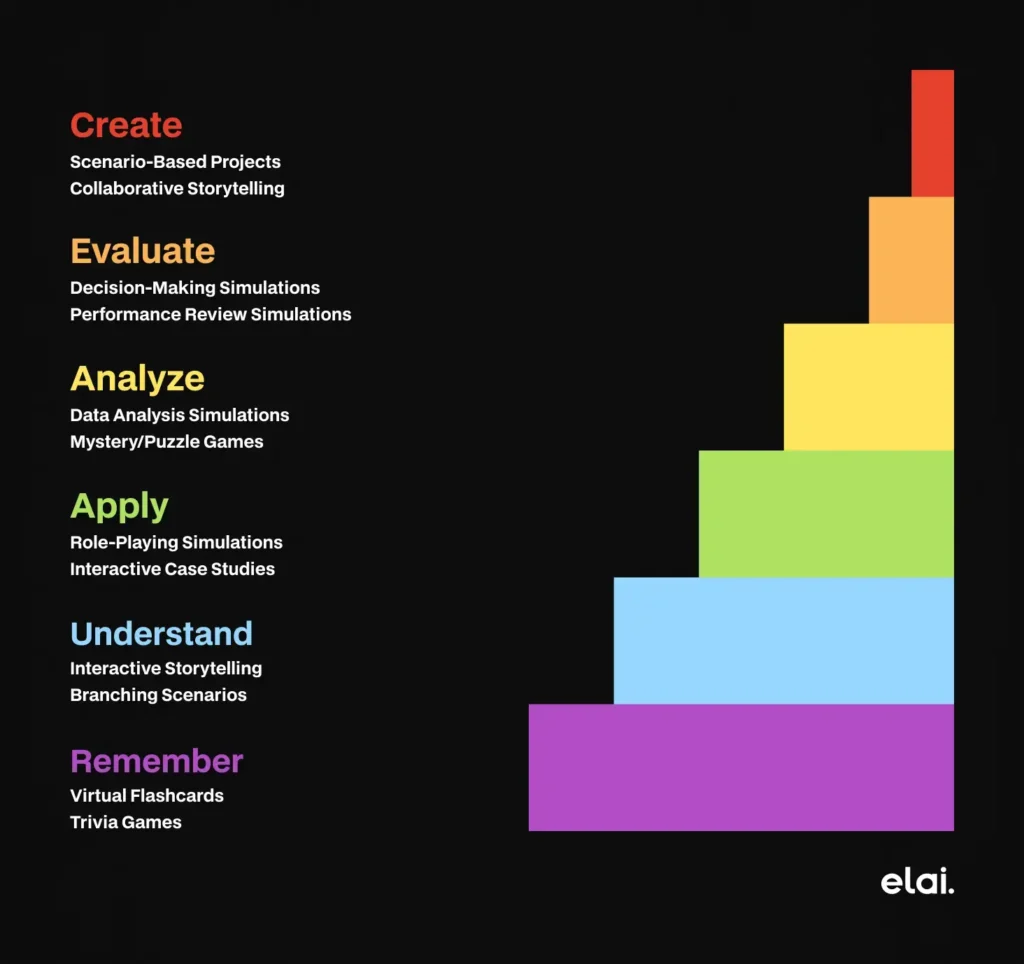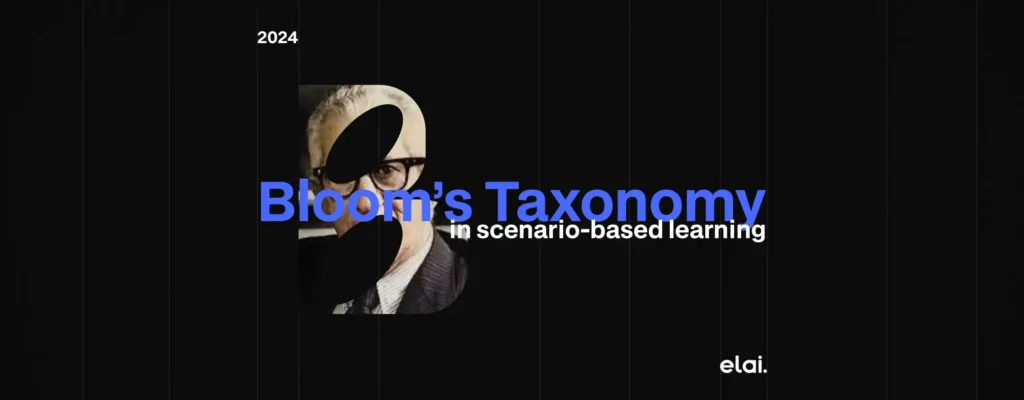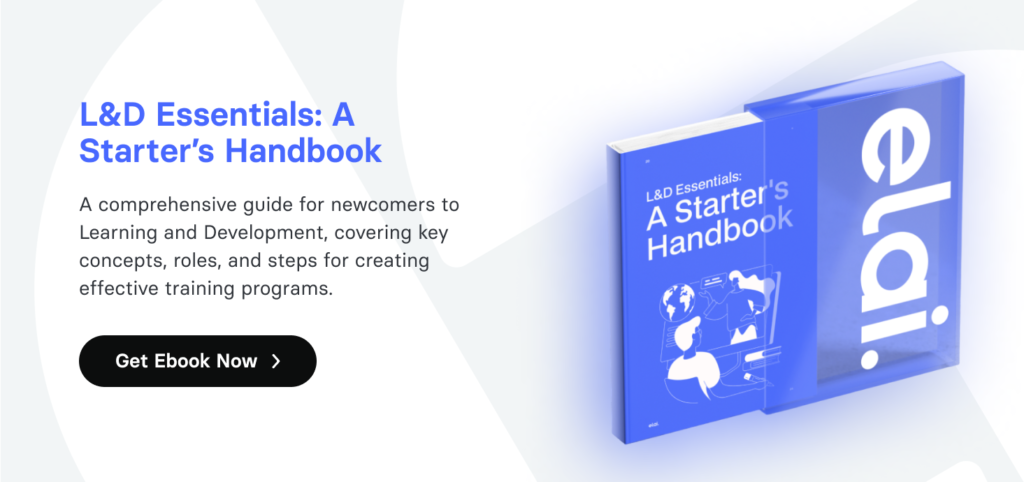Learning objectives are divided into six cognitive levels using Bloom’s Taxonomy, a hierarchical framework that is utilized in education and is arranged in ascending order of complexity. The taxonomy, which was discovered in the 1950s by educational psychologist Benjamin Bloom, helps teachers to create lessons that focus on various cognitive abilities. If you have any questions about Bloom’s taxonomy, this article may help you to answer them.
The six levels of Bloom’s Taxonomy (verbs from bloom’s taxonomy) are:
- Remembering: Recalling facts, terms, or basic concepts.
- Understanding: Explaining ideas or concepts in one’s own words.
- Applying: Using knowledge in new situations or contexts.
- Analyzing: Breaking down information into its component parts.
- Evaluating: Making judgments or assessments based on criteria.
- Creating: Generating original ideas, products, or solutions.
The revised Bloom’s Taxonomy cognitive process dimension is represented visually in Bloom’s Taxonomy Wheel, which combines the six cognitive skill levels with related action verbs and tasks to support instructional design and evaluation. Educators and instructional designers may depict the growth of cognitive processes from simple knowledge recall to advanced creative thinking with the help of this useful circle graphic.
Higher levels necessitate more sophisticated cognitive processes as each level builds upon the one before it. Teachers can use Bloom’s taxonomy action verbs as a framework to create learning objectives, assessments, and instructional practices that encourage creativity, critical thinking, and problem-solving.
By immersing students in real-world scenarios or simulations, scenario-based learning, on the other hand, enables them to apply their knowledge and abilities to solve issues and make decisions. Using actual scenarios to contextualize learning, students participate in active and experiential learning that improves their comprehension, recall, and application of knowledge to real-world situations.
To encourage deeper comprehension and critical thinking, instructors can create the Bloom’s Taxonomy example questions framework that are specific to each cognitive level. For instance, “What are the three states of matter?” may be a query at the Remember level. As we move toward Understanding, one can ask, “Can you explain why evaporation occurs?” “How would you demonstrate the conservation of mass in a chemical reaction?” is a question that may come up during the Apply stage. Asking, “What is the relationship between temperature and gas pressure?” might be a good place to start when moving to Analyze. “Can you assess the effectiveness of different insulating materials?” is a question an instructor could have for Evaluate. The last possible question at the Create level would be, “Design an experiment to test how surface area affects heat loss.” These examples show how Bloom’s Taxonomy directs the construction of questions that promote learning at all levels of cognitive complexity, from basic recall to sophisticated application and creativity.

The Synergy of Bloom's Taxonomy and Scenario-Based Learning
The integration of Bloom’s Taxonomy with scenario-based learning creates a powerful synergy that maximizes learning impact. By aligning scenarios with specific cognitive levels of the taxonomy, trainers can ensure that learning experiences are targeted, comprehensive, and effective. Scenarios addressing lower levels of Bloom’s Taxonomy center on factual recall and comprehension, while those targeting higher levels focus on critical thinking, analysis, and synthesis.
This synergy is particularly valuable in corporate training contexts, where the goal is to impart the job-specific knowledge and skills employees need to excel in their roles. By presenting learners with scenarios that parallel real-world challenges they may encounter on the job, organizations can promote the development of job-relevant competencies that are highly practical. Furthermore, integrating Bloom’s Taxonomy ensures that the learning programs address a variety of cognitive skills, preparing employees for the diverse problems and opportunities they will encounter on the job.
The Importance of Implementing Bloom’s Taxonomy in Scenario-Based Learning
Implementing Bloom’s Taxonomy is scenario-based learning is important for several reasons. Firstly, it allows organizations to focus on specific learning outcomes and competencies, so that the learning programs align with organizational goals and the needs of employee development. When learning objectives are clearly defined for each level of the taxonomy, scenarios can be constructed to effectively scaffold learners’ understanding and skill development.
Secondly, using Bloom’s Taxonomy fosters higher-order thinking among learners. Due to the nature of scenario-based learning, the activities that take place are naturally those that require critical thinking, problem-solving, and decision making — extremely important skills for work environments today. By engaging learners in the analysis, evaluation, and creation of solutions presented in scenarios, organizations encourage intellectual development and innovation in their employees.
Finally, integrating Bloom’s Taxonomy improves the transfer of learning from the learning environment to the work environment. By showing learners how to apply what they’ve learned in the context of relevant and realistic scenarios, organizations allow learners to practice using their knowledge and skills within the confines of real life: This not only solidifies memory and recall, but means that the employees are much better prepared to use the knowledge that they’ve gained through training to solve any challenges that they come across in their everyday work.
Strategies for Implementing Bloom's Taxonomy into Scenario-Based Learning
When integrating Bloom’s Taxonomy into scenario-based learning, organizations should do so carefully. The following strategies can ensure a smooth execution:
Clearly Defined Learning Objectives. Start by clearly defining measurable learning objectives for the cognitive levels of Bloom’s Taxonomy, ensuring that learning is linked to strategic organizational goals and the needs of each employee for the job at hand.
Authentic Scenarios. Construct scenarios that best reflect a learner’s job duties and skill requirements, showing them realistic situations and challenges that they will come across at their job.
Graduated Complexity. Scenarios should increase in complexity as a learner advances in a program, creating a learning and understanding that progresses gradually over time.
Reflect and Supply Feedback. Offer lots of feedback on a learner’s performance in each scenario, and give them the opportunity to reflect on and evaluate their progress so that they can consolidate their learning and understand where they can continue to improve.
Simulation-based techniques for each component of Bloom's Taxonomy
They provide learners with opportunities to engage in immersive, interactive experiences that align with the cognitive demands of each phase. Each technique can be used independently to create a specific type of experience, or you could use a variety of them along with other non-simulation-centric activities to build a blended learning experience that encompasses a wide variety of learning styles and preferences.
- Remembering
– Virtual Flashcards: Create virtual flashcards that learners can use to remember key facts, terms, or definitions by having them recall that information in a simulation environment.
– Trivia Games: Develop simulation-based trivia games that require learners to answer multiple-choice questions to reinforce knowledge of facts. - Understanding
– Interactive Storytelling: Use interactive storytelling to create a scenario with a complex narrative that learners must understand to make decisions.
– Branching Scenarios: Develop branching scenarios that require learners to understand various aspects of a situation to make choices that impact the outcome of the story. - Applying
– Role-Playing Simulations: Integrate role-play into a simulation environment that enables learners to apply knowledge and skills to real-world scenarios.
– Interactive Case Studies: Create simulation-based case studies that immerse learners in the application of theoretical knowledge to practice and require them to apply their knowledge in context. - Analyzing
– Data Analysis Simulations: Develop simulations that present learners with data sets or scenarios they must analyze, from which they draw conclusions and make informed choices.
– Mystery/Puzzle Games: Build single- and multi-player mystery or detective-style games in which learners must analyze evidence and clues to make decisions and solve problems, such as a scenario in which they are detectives for a day, a medical sleuth solving a diagnostic conundrum, etc. - Evaluating
– Decision-Making Simulations: Build simulations in which learners are presented with a series of decision points, and they must evaluate options available to them, consider the consequences of their choices, and make educated judgments about which direction to take the story.
– Performance Review Simulations: Create simulations in which learners engage in performance reviews or evaluations. They must evaluate different approaches to conducting the performance review or evaluation, decide which works best, and providing feedback to the “employee” in the simulation. - Creating
– Scenario-Based Projects: Create a comprehensive scenario-based project by which learners must synthesize information from a variety of sources and create a solution, product, presentation, etc.
– Collaborative Storytelling: Use collaborative storytelling to develop a scenario that requires learners to work together to create as they synthesize information and build upon each other’s ideas throughout the story.

Examples of Scenario-Based Learning Training Programs Based on Bloom's Taxonomy
Here, you can download Bloom’s taxonomy pdf with examples of training programs in 3 different topics.
Leadership Development Program
Overview: The Corporate Leadership Development Program is a comprehensive training initiative designed to cultivate leadership competencies among mid-level managers within the organization. This program integrates scenario-based learning with storytelling elements and is structured according to Bloom’s Taxonomy to ensure a holistic approach to skill development.
Learning Material: The learning material is divided into modules, each focusing on specific leadership competencies aligned with Bloom’s Taxonomy:
Module 1: Remembering
Learning Objective: Recall foundational theories and concepts of leadership.
Learning Material: Interactive e-learning modules covering leadership theories, models, and best practices.
Scenario: A scenario-based case study where learners analyze historical examples of effective leadership styles and their impact on organizational success.
Module 2: Understanding
Learning Objective: Understand the role of emotional intelligence in leadership.
Learning Material: Video lectures and self-assessment quizzes on emotional intelligence and its relevance to leadership.
Scenario: A storytelling scenario where learners follow the journey of a fictional leader who demonstrates emotional intelligence in various workplace situations, reflecting on their own emotional intelligence competencies.
Module 3: Applying
Learning Objective: Apply leadership skills in diverse workplace scenarios.
Learning Material: Interactive simulations and role-playing exercises on conflict resolution, team management, and decision-making.
Scenario: A virtual reality simulation where learners navigate challenging leadership scenarios, such as managing a team during a crisis or mediating conflicts among team members.
Module 4: Analyzing
Learning Objective: Analyze leadership challenges and opportunities.
Learning Material: Case studies and group discussions on real-world leadership dilemmas.
Scenario: A series of case studies where learners analyze complex leadership situations, identify underlying issues, and propose strategic solutions based on their analysis.
Module 5: Evaluating
Learning Objective: Evaluate leadership effectiveness and performance.
Learning Material: Peer feedback exercises and 360-degree assessments on leadership competencies.
Scenario: A storytelling scenario where learners assume the role of a leadership coach, providing constructive feedback to fictional leaders based on their observed behaviors and performance.
Module 6: Creating
Learning Objective: Synthesize learning to develop a personal leadership development plan.
Learning Material: Self-reflection activities and goal-setting exercises.
Scenario: A storytelling scenario where learners craft their own leadership narrative, outlining their vision, values, and goals as aspiring leaders within the organization.
Tests and Assessments:
Formative Assessments: Quizzes and knowledge checks at the end of each module to assess learners’ understanding of key concepts.
Scenario-Based Assessments: Performance evaluations based on learners’ responses to simulated leadership scenarios, focusing on their ability to apply leadership skills in context.
Final Assessment: A comprehensive exam covering all modules, including multiple-choice questions, scenario analyses, and essay questions, to evaluate learners’ mastery of leadership competencies according to Bloom’s Taxonomy.
Sales Effectiveness Training Program
Overview: The Sales Effectiveness Training Program is designed to enhance the selling skills and strategies of sales representatives within the organization. This program utilizes scenario-based learning and storytelling techniques while aligning with Bloom’s Taxonomy to ensure comprehensive skill development.
Learning Material:
Module 1: Remembering
Learning Objective: Recall fundamental sales concepts and techniques.
Learning Material: Interactive modules covering sales fundamentals, product knowledge, and sales process.
Scenario: A storytelling scenario where learners follow the journey of a sales representative navigating various sales situations, recalling key sales techniques and strategies.
Module 2: Understanding
Learning Objective: Understand customer needs and buying behavior.
Learning Material: Video lectures and case studies on customer psychology and buyer personas.
Scenario: Role-playing exercises where learners analyze customer profiles, identify needs, and develop tailored sales approaches.
Module 3: Applying
Learning Objective: Apply consultative selling techniques in sales interactions.
Learning Material: Simulated sales calls and objection-handling exercises.
Scenario: Virtual sales simulations where learners engage with simulated customers, apply consultative selling techniques, and overcome objections.
Module 4: Analyzing
Learning Objective: Analyze sales data and performance metrics.
Learning Material: Data analytics tools and case studies on sales performance analysis.
Scenario: Scenario-based exercises where learners analyze sales reports, identify trends, and make data-driven decisions to improve sales performance.
Module 5: Evaluating
Learning Objective: Evaluate sales strategies and effectiveness.
Learning Material: Peer feedback sessions and sales pitch evaluations.
Scenario: A storytelling scenario where learners assess the effectiveness of different sales strategies and pitches, providing constructive feedback to their peers.
Module 6: Creating
Learning Objective: Synthesize learning to develop personalized sales strategies.
Learning Material: Sales strategy templates and goal-setting exercises.
Scenario: Role-playing exercises where learners develop customized sales strategies based on their analysis and learning, incorporating elements of storytelling to create compelling sales narratives.
Tests and Assessments:
Role-Play Assessments: Performance evaluations based on learners’ role-playing exercises and sales simulations, assessing their ability to apply sales techniques effectively.
Sales Pitch Assessments: Evaluation of learners’ sales pitches, focusing on their ability to communicate value propositions and address customer needs.
Final Sales Scenario Analysis: A comprehensive analysis of a complex sales scenario, requiring learners to apply their knowledge and skills to develop a strategic sales plan and present their recommendations.
Diversity and Inclusion Training Program
Overview: The Diversity and Inclusion Training Program aims to foster a culture of diversity, equity, and inclusion within the organization. This program leverages scenario-based learning, storytelling, and Bloom’s Taxonomy to facilitate meaningful learning experiences and promote inclusive behaviors among employees.
Learning Material:
Module 1: Remembering
Learning Objective: Recall foundational concepts of diversity and inclusion.
Learning Material: Interactive modules covering diversity dimensions, unconscious bias, and inclusive language.
Scenario: A storytelling scenario where learners explore the experiences of diverse individuals and reflect on the importance of understanding different perspectives.
Module 2: Understanding
Learning Objective: Understand the impact of biases and stereotypes on workplace dynamics.
Learning Material: Video lectures and case studies on unconscious bias and its effects.
Scenario: Role-playing exercises where learners identify biases in workplace scenarios and practice strategies for mitigating bias.
Module 3: Applying
Learning Objective: Apply inclusive communication and behavior in the workplace.
Learning Material: Role-playing scenarios and communication exercises.
Scenario: Virtual reality simulations where learners navigate challenging conversations and interactions, applying inclusive communication techniques.
Module 4: Analyzing
Learning Objective: Analyze diversity and inclusion challenges in the workplace.
Learning Material: Case studies and group discussions on real-world diversity issues.
Scenario: Scenario-based exercises where learners analyze diversity-related incidents, identify root causes, and propose solutions.
Module 5: Evaluating
Learning Objective: Evaluate organizational policies and practices for inclusivity.
Learning Material: Policy reviews and organizational assessments.
Scenario: A storytelling scenario where learners assess the inclusiveness of organizational policies and practices, providing recommendations for improvement.
Module 6: Creating
Learning Objective: Synthesize learning to develop inclusive leadership strategies.
Learning Material: Leadership development resources and reflective exercises.
Scenario: Role-playing exercises where learners practice inclusive leadership behaviours, incorporating storytelling elements to create inclusive work environments.
Tests and Assessments:
Inclusive Behavior Assessments: Evaluation of learners’ participation in role-playing exercises and simulations, assessing their ability to apply inclusive behaviors effectively.
Case Study Analysis: Analysis of diversity-related case studies, requiring learners to identify issues, propose solutions, and justify their recommendations.
Final Inclusive Leadership Plan: Development of a comprehensive inclusive leadership plan, outlining strategies for promoting diversity and inclusion within the organization.
Bloom’s Taxonomy and scenario-based learning, particularly in corporate training, provide a sophisticated approach to enabling skill and knowledge acquisition. By integrating the two, organizations can create learning experiences that are both engaging and effective, thus equipping their employees to excel in their roles to drive their success and the success of the organization. Moreover, this advanced approach allows companies to maximize the impact of their training programs and foster a culture of continuous learning and growth.
FAQ
What is Bloom's taxonomy?
Bloom’s Taxonomy is a hierarchical framework used to classify educational learning objectives into levels of complexity and specificity, from basic knowledge recall to higher-order thinking skills.
Why is Bloom’s taxonomy important?
Bloom’s Taxonomy is crucial because it gives teachers a methodical way to create and evaluate curricula, guaranteeing that students advance through more difficult comprehension and application levels.
How to use Bloom's taxonomy?
Educators can use Bloom’s Taxonomy by matching tasks and lessons to the different levels of the taxonomy and using action verbs that are unique to each level to make clear, measurable learning goals and tests.
How to write learning objectives using Bloom's taxonomy?
To write learning objectives using Bloom’s Taxonomy, start by identifying the desired level of cognitive skill (e.g., Remember, Understand, Apply) and then choose an action verb that corresponds to that level, followed by a specific, measurable outcome that students should achieve.

